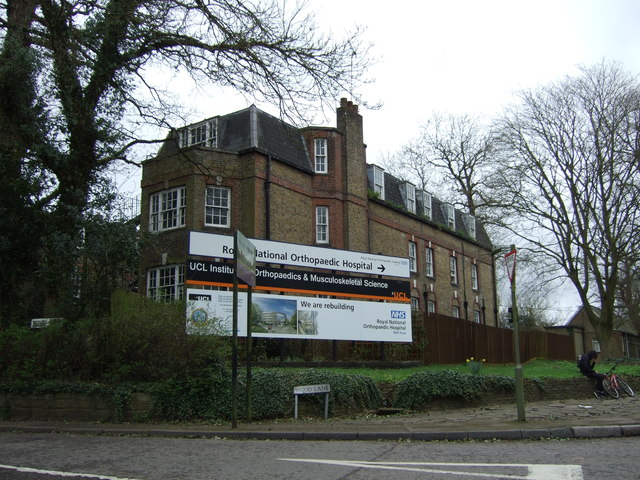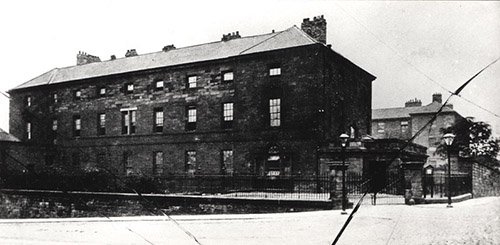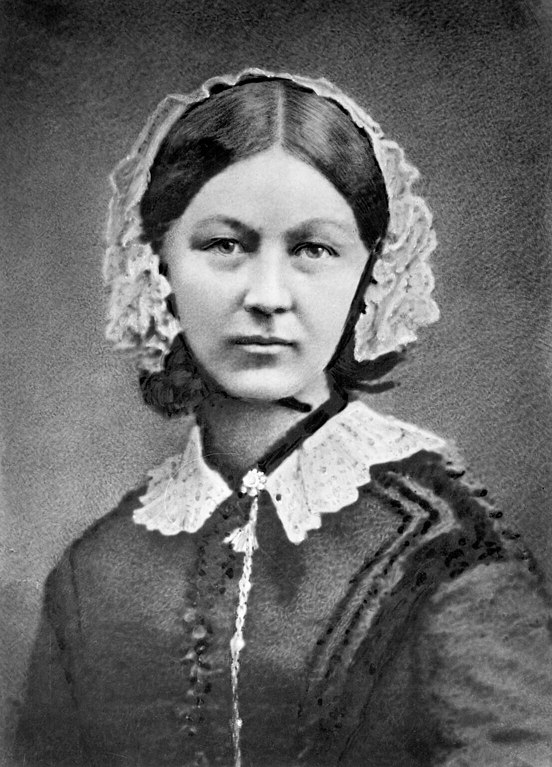If you go looking for ghost stories, you very quickly stumble across haunted hospitals. In fact, it was finding so many tales about Cardiff Royal Infirmary that prompted this post in the first place.
And not all of the stories are necessarily sad. The resident ghost at St Nicholas Hospital in Newcastle upon Tyne is known as ‘Matron’, but she’s also said to be friendly.
Meanwhile, Rev. Anthony Apps exorcised St Mark’s Hospital in Islington in 1977. He used prayers and holy water after nurses reported unexplained noises, footsteps in empty corridors, banging and moaning. Apparently, the phenomena ceased after Apps left (Warschauer 1977: 4).
But we’re going to go beyond the typical hospitals of the internet listicle. Let’s dig into the newspapers and local history to find our tales of haunted hospitals…
As a content warning, many tales involve suicide, death, or violence in some way. If this will be difficult for you, feel free to skip this week’s instalment. Take whatever care of yourself that you need.
The Lying-In Hospital
Hospitals haven’t always existed in the format we know them now in the UK. In the past, different funding methods might be used. Subscriptions were one such method, used in 1760 to create a Lying-In Hospital in Newcastle upon Tyne. It provided maternity services for poor married women, excluding unmarried women.
By the early 19th century, demand outstripped supply, and the city needed a new hospital. Architect John Dobson, one of Newcastle’s favourite sons, waived his fee to design the building. You can still see it opposite the Laing Art Gallery on New Bridge Street West. The new hospital opened in 1826, though a century later, the overcrowded building suffered from poor maintenance. Eventually, it moved to new premises on Jubilee Road in 1923.
But what of the building left behind? The BBC took over its lease in 1925 to use it for offices and studios. The old Lying-In Hospital became Broadcasting House. Eventually, it even gained a TV studio, but it seems some of its earlier residents didn’t leave.
Engineers working late at night heard footsteps in empty corridors. Even weirder, the steps were those of heels on a stone floor…though carpet covered the corridor’s floor (Histon 2001: 7). On another occasion, a worker toured the building to secure all the doors, so he knew the building was empty. He entered the control room to adjust the clock and heard someone come into the room behind him. When he turned to ask how they got in, he realised he was alone (Histon 2001: 8). People came to call this spirit the White Lady and assumed she must have been a mother or a nurse.
One Burns Night, an announcer read the news and ghostly bagpipes could be heard, though no one ever traced the source of the music. A ghostly cat even appeared in the building one Christmas (Histon 2001: 8).
The BBC left in 1988, and the Newcastle Building Society took it over for a while. The building was apparently gutted as part of renovations, and no one has reported anything eerie since.
The Porter Who Never Left
The Manchester Evening News reported in 1899 that “one of the large Liverpool hospitals is firmly believed […] to be haunted” (1899: 5). They didn’t want to name the institution, but said it was “one of the largest and best known of the medical charities” (1899: 5). The article goes on to note that the stories come almost exclusively from the nurses, while also noting that “[n]urses are not usually accounted superstitious” (1899: 5).
According to them, a porter had slit his own throat “in a small room off one of the main landings” (1899: 5). Staff carried him along a corridor “to the large ward called after an eminent nurse, whose name is well-known to Englishmen” (1899: 5), but he sadly died.
Nurses sometimes saw the porter standing in or walking along the same corridor. While he looked perfectly at home, he disappeared if anyone spoke to him or approached him. The matron banned discussion of the ghost in case it scared the nurses on probation. One nurse reported that she and the ward sister saw the ghost at the same time. He stood outside the ward’s door, visible through a glass door. The sister told her to go and find out what he wanted, but the nurse declined. The sister ridiculed the nurse and went herself, but the ghost disappeared, scaring the sister. The nurse reported that she still often saw the porter, but because he did nothing to alarm anyone, she considered him “a privileged visitor” (1899: 5).
I tried to work out which hospital this might have been, but the city has had almost fifty different hospitals. Some have been demolished, others have been put to a different use. It’s clear the ‘large ward’ where the porter was carried was named after Florence Nightingale. She advised Alfred Waterhouse on the design and ventilation of the wards at Liverpool Royal Infirmary when it moved to a new building in 1890 (National Museums Liverpool 2023). Perhaps this is the hospital the article meant? If you know, feel free to comment and let me know!
The Grey Lady of the Royal National Orthopaedic Hospital
The Royal National Orthopaedic Hospital stands on Brockley Hill in Stanmore. At one point, it boasted a grey lady. According to the legend, a child died at the hospital on November 13, although the year is predictably vague. This is our first clue it may not be a genuine legend. In the story, the following year at midnight on November 13, staff reported seeing “a mournful grey figure” drifting around Coxcon Ward searching for her child (Harrison 1991: 13).
Every year at midnight on the anniversary, other children using the cot where the child died woke up screaming. Nurses tried moving the cot to a different ward, but the same thing happened. Eventually, they burned it to try to get rid of the haunting.

It didn’t seem to have worked, because sightings of the grey lady continued, though less often. The Enfield Parapsychic Research Group investigated the hospital in November 1991, though the grey lady made no appearance (Harrison 1991: 13). An investigator noted the cliche nature of the story, with the yearly anniversary sparking the haunting, so perhaps it’s simply a legend that stuck.
After all, it doesn’t make sense why the boy’s mother would appear every year unless she also died.
Hospitals that Haunt After Demolition
It seems some stories linger even after the building itself is long gone. Ghost stories already clung to Birkenhead General Hospital, which closed in 1982. Those who used the building before it was demolished in 1993 experienced odd events. Wirral Play Council used the hospital and one of its staff reported that people found the library too eerie. One night, he even found the double doors swinging, seemingly of their own accord. He expected to see his colleague, but she was elsewhere in the building at the time (Daniels 1998: 2).
Houses were built on the site, and residents in Livingstone Street reported strange phenomena. In 1998, one resident reported hearing an identical noise in another room as she puffed up bedroom pillows. Yet in the other room, the pillows were completely flattened. Those in the terraces also reported objects going missing, rooms far colder than they should have been, and other unexplained phenomena (Daniels 1998: 2). Are these patients that never left the hospital?
Ghosts at the Centre for Life
In Newcastle upon Tyne, the Centre for Life stands on the site of the original Infirmary, which handled infectious diseases. All that remains of the old site is the market house, which was an office for the nearby cattle market. The authorities demolished the Infirmary in 1956 and the land lay largely derelict until the 1990s, when the Centre for Life got planning approval.

Contractors found the bones of around 1000 people while clearing the site for the Centre for Life. Yet disturbing this makeshift cemetery seemed to disturb something else. A strange and unpleasant atmosphere pervaded the market house, which also became incredibly cold. People left things there, only for them to disappear.
While scientists sent some of the bones to the University of Sheffield for analysis, they re-interred others. Vanessa Histon suggests the disturbances ended when the excavation work finished (2001: 5); paranormal investigator Steve Watson disagrees. He reports that visitors saw a child dressed in Victorian attire near the 4D motion ride inside the Centre for Life. When the staff checked, the area was empty (2021: 47). Elsewhere in the building, a subterranean corridor connects the maintenance workshops. Workers hear voices in this area, while items apparently disappear from one room, only to reappear elsewhere (2021: 47).
Are these the restless spirits of those who died in the Infirmary? Or staff who never quite moved on? Who knows…
The Guinea Ghost of Bedlam
Finally, I couldn’t write a post about hospital folklore without including perhaps the most infamous, or should I say notorious, hospital in England…the Royal Bethlem Hospital, more popularly known as Bedlam. In one of its legends, a female ghost glided around the building, clutching a guinea.
According to legend, the ghost was that of Rebecca Griffiths, a servant in a house on Fish Street Hill, near the Monument to the Great Fire of London. In 1878, a relative of her employers came to stay, and Rebecca became peculiarly attached to him. At the moment he was due to leave, he pressed a guinea into her hand and left in his chaise. Rebecca apparently ran after it, and she was only apprehended when she reached Borough, across London Bridge.
Her captors deemed her to be mad, and took her to Bethlehem Hospital, which by this point stood at St. George’s Field. Rebecca eventually died there, without once giving up her guinea that she continued to grasp. As she lay dying, she asked that they would bury her with it. The legend explains that a warder stole it, and her ghost still wanders the building looking for it (Payn 1894: 4).
That doesn’t explain why people saw the ghost clutching the guinea. But given the building is now the Imperial War Museum, I do wonder if she continues to wander the site, or if her favourite haunt was the wings that no longer stand.
What do we make of these tales of haunted hospitals?
I think we should turn to an article I found from 1975 in the Liverpool Echo to answer this question. It quotes Andrew Green, cited as lecturing “on ghost-hunting for the Kent and East Sussex education authorities” (1975: 8). According to Green, “middle-aged nurses dressed in old-fashioned uniforms” haunt London’s top hospitals like St Thomas’s, Guy’s, and St George’s.
Both patients and staff report seeing ghosts. Though between 1956 and 1959, five patients at St Thomas’s “saw a grey lady dressed as a pre-1920s nurse” (1975: 8). Apparently, the experience didn’t frighten them, but they all died shortly after seeing her. In an interesting twist, the nurse apparently gave them all cups of water or tea. This reminds me of the death omen at Cardiff Royal Infirmary, where those who accepted an offered glass of water from a ghostly nurse soon died. It would be fascinating to know if this death omen appears in other hospitals.
Meanwhile, at the Addenbrooks’ Hospital in Cambridge, nurses measuring out morphine would sometimes hear someone telling them to be careful. They believed the voice belonged to a nurse who accidentally gave a patient an overdose (1975: 8).
So are these lingering ghosts actually staff, keen to continue their duties after death? The Liverpool porter would suggest that might be the case.
Or are some of them the shades of those who went into hospital and never came out? If so, hopefully they can find their way to somewhere more peaceful.
Do you know any tales of haunted hospitals? Let me know below!
References
Daniels, Sarah, and Alex Wafer (1998), ‘Investigating spooky spots’, Hoylake & West Kirby News, 28 October, p. 2.
Harrison, Simon (1991), ‘Ghostbusters kept waiting by a grey lady’, Stanmore Observer, 28 November, p. 13.
Histon, Vanessa (2001), Ghosts of Grainger Town: Further Tales from Newcastle’s Darker Side, Newcastle upon Tyne: Tyne Bridge Publishing.
Liverpool Echo (1975), ‘The hospitals where ghosts give warning of death…’, Liverpool Echo, 2 June, p. 8.
Manchester Evening News (1899), ‘A Haunted Hospital in Liverpool’, Manchester Evening News, 26 July, p. 5.
National Museums Liverpool (2023), ‘Medical Pembroke Place’, National Museums Liverpool, https://www.liverpoolmuseums.org.uk/galkoffs-history/medical-pembroke-place.
Payn, James (1894), ‘Love at First Sight’, Toronto Saturday Night, 4 August, p. 4.
Warschauer, Harry (1977), ‘Exorcised – Nurses’ Haunted Hospital’, Sunday People, 25 September, p. 4.
Watson, Steve (2021), Paranormal Newcastle, Stroud: Amberley Publishing.



![Old postcard of Birkenhead Borough Hospital c.1900 [Public domain], via Wikimedia Commons](https://www.icysedgwick.com/wp-content/uploads/2023/09/Birkenhead_Borough_Hospital.jpg)








hey, do you have any sources for this story about rebecca griffiths?
All the sources I used are in the references list at the bottom of the post, but I see I referenced Payn 1894 in the body of the article, so I’d advise starting there. Hope that helps!